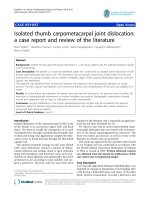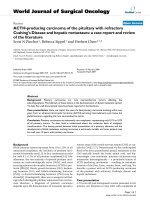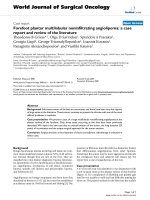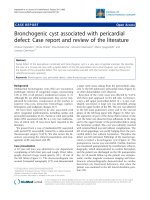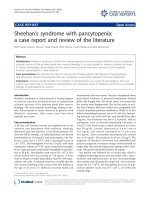Báo cáo y học: "ronchogenic cyst associated with pericardial defect: Case report and review of the literature." pptx
Bạn đang xem bản rút gọn của tài liệu. Xem và tải ngay bản đầy đủ của tài liệu tại đây (1.02 MB, 5 trang )
CASE REP O R T Open Access
Bronchogenic cyst associated with pericardial
defect: Case report and review of the literature
Andrea Imperatori
1
, Nicola Rotolo
1
, Elisa Nardecchia
1
, Giovanni Mariscalco
2
, Marco Spagnoletti
1
and
Lorenzo Dominioni
1*
Abstract
Partial defect of the pericardium combined with bronchogenic cyst is a very rare congenital anomaly. We describe
the case of a 32-year-old man with a partial defect of the left pericardium and a bronchogenic cyst arising from
the border of the pericardial defect. The cyst was successfully resected with the harmonic scalpel by three-port
videothoracoscopic approach.
Keywords: Bronchogenic cyst, pericardial defect, video-thoracoscopy, harmonic scalpel
Background
Mediastinal bronchogenic cysts (BC) are uncommon
pathologic entities of congenital origin, representing
12% to 18% of all primary mediastinal masses [1-3].
Although BC are often asymptomatic, they can be com-
plicated by infection, compression of the trachea or
superior vena cava, intracystic hemorrhage, rupture,
hemoptysis, and malignant changes [4-7].
BC have been reported to be also associated with
other congenital malformations, including cardiac and
pericardial anomalies [8-21]. Partial or total pericardial
defect (PD) associated with BC is a very rare malforma-
tion, of which only 19 cases have bee n reported in the
literature.
We present here a case of mediastinal BC associated
with partial PD, successfully treated by a video-assisted
thoracoscopic surgery (VATS) . We also review the lit-
erature concerning the clinical presentation and man-
agement of BC associated with PD.
Case presentation
A 32-year-old man was admitted to our department
complaining of left chest pain and cough. Chest radio-
graphy showed a large round opacity (10 × 10 cm) of
the left hilum (Figure 1). The electrocardiogram was
normal. Computed tom ography (CT) scan demonstrated
a large cystic mass arising from the pericardium, adja-
cent to the left pulmonary pericardial sinus (Figure 2);
no other abnormalities were observed.
Resection of the cystic mass was effected by VATS,
with three-port approac h on the left side. At thoraco-
scopy a left upper pericardial defect (3 × 4 cm), oval-
shaped, was found. A large cyst was identified, arising
from the upper border of the PD. The cyst was adherent
to the left main pulmonary artery and to the visceral
pleura of the left lung upper lo be (Figure 3 ). After nee-
dle aspiration of part of the dense fluid content of the
cyst, the latter was dissected from adhesions to the lung
and to the upper border of the pericardial defect, using
the harmonic scalpel. The cyst was radically resected
with minimal blood loss and without complications. The
left atrial appendage was partly bulging from the peri-
cardial defect, but without herniation. Therefore the
defect was left untreated. Pathology of the resected spe-
cimen revealed a bronchogenic cyst (Figure 4). The
postoperative course was uneventful. Cardiac function
was monitored postoperatively by transthoracic echocar-
diography, which de monstrated no cardiac herniation,
and the patient was discharged on the 5th postoperativ e
day. At 18-month follow-up the patient was asympto-
matic; cardiac magnetic resonance imaging and trans-
thoracic echocardiography demonstrated no cardiac
herniation nor functional deficiency, also when the
patient was examined in the left lateral decubitus posi-
tion [22].
* Correspondence:
1
Department of Surgical Sciences, Thoracic Surgery Unit, Varese University
Hospital, University of Insubria, Varese, Italy
Full list of author information is available at the end of the article
Imperatori et al. Journal of Cardiothoracic Surgery 2011, 6:85
/>© 2011 Imperatori et al; licensee BioMed Ce ntral Ltd. This is an Open Access article distributed unde r the terms of the Creative
Commons Attribution License (http://creativecom mons.org/licenses/by/2.0), which permits unr estricted use, distribution, and
reprodu ction in any medium, provided the original work is properly c ited.
Discussion
BC are the most common cystic lesions of the mediasti-
num and account for 18% of all primitive mediastinal
masses. The prevalence of BC is difficult to ascertain,
because they frequently are asymptomatic [5,23-26].
While most BC are located in t he mediastinum, 15% to
30% of them are found within the lung parenchyma; in
the latter case the lower lobes are most commonly
involved [1-3]. Atypical locations of BC are also
reported, including the neck, the spinal dura mater and
the diaphragmatic region [1-3]. BC are c ongenital mal-
formations arising from the primitive foregut with an
abnormal division of the tracheobronchial tree; the stage
of embryonic development determines the mediastinal
location [26]. I n case of early separation from the main
tracheobronchial tree, BC are located in the mediasti-
num close to the trachea, carina, main bronchi or eso-
phagus; histologically these entities present ciliated
epithelium derived from either the respiratory or the ali-
mentary tract. When the separation occurs late, BC
involve the lung parenchyma and the cysts present a
Figure 1 Chest X-rays showing mediastinal mass.ChestX-ray
showing a large round opacity of the left hilum.
Figure 2 CT scan showing cystic mass. CT scans showing a well
circumscribed cystic mass (10 × 10 cm) adjacent to the left
pulmonary artery (arrow).
Figure 3 Intraoperative video-thoracoscopic detail.
Intraoperative view showing bronchogenic cyst (BC), left atrial
appendage (LA) visible through the pericardial defect (arrows),
phrenic nerve (PhN), left upper lobe of the lung (L).
Figure 4 Histology of cystic mass. Histological section of th e
bronchogenic cyst, showing ciliated epithelium and cartilages (HE
stain, 20X)
Imperatori et al. Journal of Cardiothoracic Surgery 2011, 6:85
/>Page 2 of 5
lined respiratory epithelium [5,27]. BC are most fre-
quently unilocular; their fluid content may be clear, or
dense and yellow, or hemorrhagic, or mixed with a ir in
case of intrapulmonary location of the cyst.
No clinical presentation is specifically suggestive of
BC because these lesions are frequently asymptomatic,
their diagnosis being incidental [6,23]. Chest pain,
cough, dyspnea, and dysphagia are reported as possible
clinical manifestations of BC, arising from compression
of the esophagus and/or m ajor airways [4-7,23]. In the
case we are reporting, the patient was symptomatic for
cough and chest pain; the preoperative diagnosis of BC
wasmadebychestradiographyandCTscan.
Complete surgical excision is the trea tment of BC
generally accepted, because these lesions do not spon-
taneously regress and can enlarge or become infected.
Several surgical techniques have been described
[5,23-26,28]. Drainage of a compressive cyst is a tem-
porary palliative procedure, generally reserved to inop-
erable patients, to the management of recurrences and
of severe compression [5,29]. Surgical approaches
include thoracotomy and VATS [5,23-26]. In the last
decade VATS has emerged for the treatment of BC in
absence of severe adhesions to surrounding mediastinal
organs [29,30]. In the present case the mediastinal BC
was resected by thoracoscopic approach, using the har-
monic scalpel, a technique that has become available
in recent ye ars and proved to be safe and effective
[31]. Harmonic scalpel confers some advantages over
conventional methods of dissection, such as electric
cautery, in VATS procedures. It reduces blood loss,
duration of drainage and length of the VATS proce-
dure with a comparable cost as compared to electric
cautery. Similar advantages of harmonic scalpel have
been observed in other surgical fields, such as thyroid
surgery [32], video-assisted thoracoscopic thymic
resection [33] and vascular surgery [34].
Various congenital anomalies of the heart, lung,
chest wall and diaphragm have been reported to be
associated with BC. PD, patent ductus arteriosus, atrial
septal defect, tetralogy of Fallot, mitral stenosis, pul-
monary sequestration and diaphragmatic hernia have
been encountered in association with BC [4,5]. During
development of the pleuropericardial fold, pericardial
defectsandlunganomaliessuchasbronchogeniccyst
may occur together [15]; this event is unlikely to be co-
incidental. I n the present case, a partial PD was inciden-
tally discovered during surgery for resection of BC. Con-
genital P D is a rare anomaly p resenting as a complete or
partial absence of the pericardium. Partial absence more
commonlyoccursontheleftside(70%)thanonthe
right (17%) or in the inferior portio n of the pericardium
[22]. The prevalence of PD is likely underestimated,
because the symptoms are absent or scarce and the
diagnostic criteria are p oorly known [35]. It should be
emphasized that the intact pericardium over the left
atrial appendage is very thin and may not be identified
even in normal people; thus, a partial left PD is nearly
impossible to be recognized by routine CT scan, unless
the atrial appendage is frankly bulging from the defect
[22].
Usually patients with PD are asymptomatic and the
diagnosis is incidental during thoracic surgery for unre-
lated conditions, as in our case.
Atypical angina symptoms or dyspnea are possible
unspecific manifestations [36]. Although small defects
occasionally induce serious or even lethal complica-
tions due to the incarceration of cardiac tissue, large
or total left-sided PDs are usually considered benign
and deserve no treatment. Surgical repair is required
in case of large cardiac herniation and imminent stran-
gulation [36].
We reviewed the literature pertinent to BC asso-
ciated to PD, and found only 17 published cases of
that combined congenital malformation. Table 1 sum-
marizes the features of the 14 cases for which com-
plete information were available (3 cases were not
reported in English language) and shows that all
patients had symptoms due to BC, while the PD was
incidentally discovered during surgery performed to
excise the cyst; left partial PD predominated, and in
only 3 cases a direct suture of the defect was
required.
To our knowledge, the case of BC associated to PD
presented here is the first described that was treated
by VATS approach, using the harmonic scalpel for
resecting the cyst. The decision to close the PD can
only be made on an individual basis, after evaluation
of the specific anatomical alterations. In our case we
did not close the partial PD because the left atrial
appendage was adherent with the inner aspect of the
pericardium and did not herniate; that decision proved
to be appropriate, because at 18-month follow-up the
transthoracic echocardiography confirmed no cardiac
herniation nor functional deficiency.
In conclusion, in the case presented the VATS
approach to resect the BC with the harmonic scalpel
and the decision to leave the PD open proved to be safe,
effective and minimally invasive.
Consent
Written informed consent was obtained from the
patient for publication of this case report and any
accompanying images. A copy of the written consent is
available for review by the Editor in Chief of this
journal.
Imperatori et al. Journal of Cardiothoracic Surgery 2011, 6:85
/>Page 3 of 5
Abbreviations
BC: bronchogenic cysts; PD: pericardial defect; VATS: video-assisted
thoracoscopic surgery; CT: Computed tomography.
Author details
1
Department of Surgical Sciences, Thoracic Surgery Unit, Varese University
Hospital, University of Insubria, Varese, Italy.
2
Department of Surgical
Sciences, Cardiac Surgery Unit, Varese University Hospital, University of
Insubria, Varese, Italy.
Authors’ contributions
All Authors: 1. have made substantial contributions to conception and design,
or acquisition of data, or analysis and interpretation of data; 2. have been
involved in drafting the manuscript or revising it critically for important
intellectual content; 3. have given final approval of the version to be published.
Competing interests
The authors declare that they have no competing interests.
Received: 16 February 2011 Accepted: 20 June 2011
Published: 20 June 2011
References
1. St-Georges R, Deslauriers J, Duranceau A, Vaillancourt R, Deschamps C,
Beauchamp G, Page A, Brisson J: Clinical spectrum of bronchogenic cysts
of the mediastinum and lung in the adult. Ann Thorac Surg 1991, 52:6-13.
2. Di Lorenzo M, Collin PP, Vaillancourt R, Duranceau A: Bronchogenic cysts. J
Pediatr Surg 1989, 24:988-91.
3. Suen HC, Mathisen DJ, Grillo HC, LeBlanc J, McLoud TC, Moncure AC,
Hilgenberg AD: Surgical management and radiological characteristics of
bronchogenic cysts. Ann Thorac Surg 1993, 55:476-81.
4. Ahn C, Hosier DM, Vasko JS: Congenital pericardial defect with herniation
of the left atrial appendage. Ann Thorac Surg 1969, 7:369-84.
5. Ribet ME, Copin MC, Gosselin BH: Bronchogenic cysts of the lung. Ann
Thorac Surg 1996, 61:1636-40.
6. PatelSR,MeekerDP,BiscottiCV,KirbyTJ,RiceTW:Presentation and
management of bronchogenic cysts in the adult. Chest 1994,
106:79-85.
7. Mondello B, Lentini S, Familiari D, Barresi P, Monaco F, Sibilio M, La
Rocca A, Micali V, Acri IE, Barone M, Monaco M: Thoracoscopic resection of
a paraaortic bronchogenic cyst. J Cardiothorac Surg 2010, 5:82-5.
8. Rusby N, Sellors T: Conegenital deficiency of the pericardium. Report of a
case. Br J Surg 1945, 32:357-64.
9. Jones P: Developmental defects in the lungs. Thorax 1955, 10:205-13.
10. Warner CL, Britt RL, Riley HD Jr: Bronchopulmonary sequestration in
infancy and childhood. J Pediatr 1958, 53:521-8.
11. Hamilton LC: Congenital deficiency of the pericardium. A case report of
complete absence of the left pericardium. Radiology 1961, 77:984-6.
12. Mukerjee S: Congenital Partial Left Pericardial Defect With A
Bronchogenic Cyst. Thorax 1964, 19:176-9.
13. Kwak DL, Stork WJ, Greenberg SD: Partial defect of the pericardium
associated with a bronchogenic cyst. Radiology 1971, 101:287-8.
Table 1 Cases of bronchogenic cyst associated with pericardial defect published in the English language literature
Author [ref] Year Case n.* Age/Sex Size
(cm)
Location Symptoms Surgical
Treatment†
Pericardial defect
Location/Extension (cm)
Other
congenital
anomalies
Rusby and Sellors
[12]
1945 1 19, F 6 L upper
lobe
Chest pain Excision L, Partial none
Jones P. [13] 1955 2 9, M - L hilum Bronchitis Excision L, Partial 3 × 2 none
3 22, M - L upper
lobe
Asymptomatic Lobectomy L, Partial (extensive) none
4 21, M - R lung apex Asymptomatic Lobectomy R, Partial 4 × 2.5 none
5 22, F - L upper
lobe
Asymptomatic Excision L, Partial, 2.5 × 2.5 none
6 9, M 10 ×
6
R lung apex Infections - R, Partial Double BC,
vascular
Warner et al. [14] 1958 7 7 1/2, M 2 × 2 L upper
lobe
Asymptomatic Excision Complete Pleural defect
Hamilton LC. [15] 1961 8 10, M - L lower lobe Pneumonia Excision L, Partial Pleural defect
Mukerjee S. [16] 1964 9 24, F - L upper
lobe
Chest pain Excision L, Partial Pleural defect
Kwak et al. [17] 1971 10 15, F 7.5 ×
5×
3.6
L hilum Asymptomatic Excision +
PDS
L, Partial 2 × 2 none
Kassner et al. [18] 1975 11 2, F 6 × 6 L upper
lobe
Asymptomatic Excision +
PDS
L, Partial 2 × 2 Hip dislocation
Victor and Daniel [19] 1981 12 14, M 5 × 4 R upper
lobe
Dyspnea,
dysphagia
Excision +
PDS
R, Partial none
Eom et al. [20] 2007 13 18, M 8 × 7
× 4.5
L
mediastinum
Cough,
dyspnea
Excision L, Partial none
Özpolat et al. [21] 2009 14 15, M - L upper
lobe
Chest pain,
dysphagia,
dyspnea
Excision L, Partial ASD, MVP,
hypospadias
Present case 2010 15 32, M 10 ×
10
L hilum Chest pain,
cough
Excision
(VATS)
L, Partial none
ASD, atrial septal defect; BC, bronchogenic cyst; F, female; L, left; R, right; M, male; MVP, mitral valve prolapse; PDS, pericardial defect sutured; VATS, video-
assisted thoracoscopic surgery.
* Details of three other cases were not listed because publications were not in English language [ref. # [23-25]].
† Surgical approach to the cysts was accomplished in all case by left or right thoracotomy.
Imperatori et al. Journal of Cardiothoracic Surgery 2011, 6:85
/>Page 4 of 5
14. Kassner EG, Rosen Y, Klotz DH Jr: Mediastinal esophageal duplication cyst
associated with a partial pericardial defect. Pediatr Radiol 1975, 4:53-6.
15. Victor S, D DI: Congenital partial pericardial defect on the right side
associated with a bronchogenic cyst. A case report. Indian Heart J 1981,
33:34-6.
16. Eom DW, Kang GH, Kim JW, Ryu DS: Unusual bronchopulmonary foregut
malformation associated with pericardial defect: bronchogenic cyst
communicating with tubular esophageal duplication. J Korean Med Sci
2007, 22:564-7.
17. Ozpolat B, Dogan OV: Absence of pericardium in combination with
bronchogenic cyst, atrial septal defect, mitral valve prolapsus and
hypospadias. Anadolu Kardiyol Derg 2009, 9:E16-7.
18. Takizawa H, Ishikura H, Kimura S, Yuasa Y, Okitsu H, Sakata A: Giant
pulmonary cyst associated with congenital pericardial defect. Gen Thorac
Cardiovasc Surg 2007, 55:65-8.
19. Horiide R, Ishikawa N, Ogata K: [Case of mediastinal bronchogenic cyst
associated with partial pericardial defect and cured by excision.]. Kyobu
Geka 1963, 16:46-50.
20. Marushkin AV, Troshin AP, Malkin DM, Lelechenko VI: [Rare case of
association of mediastinal bronchogenic cyst with pericardial defect].
Vestn Khir Im I I Grek 1978, 120:85-6.
21. Voronov AA, Gavrilov SG: [Congenital absence of the pericardium in
combination with bronchogenic cyst of the left lung.]. Grudn Khir 1962,
4:78-9.
22. Rajia P, Kanne JP: Computed tomography of the pericardium and
pericardial disease. J Cardiovasc Comput Tomogr 2010, 4:3-18.
23. Takeda S, Miyoshi S, Minami M, Ohta M, Masaoka A, Matsuda H: Clinical
spectrum of mediastinal cysts. Chest 2003, 124:125-32.
24. Sarper A, Ayten A, Golbasi I, Demircan A, Isin E: Bronchogenic cyst. Tex
Heart Inst J 2003, 30:105-8.
25. Kanemitsu Y, Nakayama H, Asamura H, Kondo H, Tsuchiya R, Naruke T:
Clinical features and management of bronchogenic cysts: report of 17
cases. Surg Today 1999, 29:1201-5.
26. Aktogu S, Yuncu G, Halilcolar H, Ermete S, Buduneli T: Bronchogenic cysts:
clinicopathological presentation and treatment. Eur Respir J 1996,
9:2017-21.
27. Takeda S, Miyoshi S, Inoue M, Omori K, Okumura M, Yoon HE, Minami M,
Matsuda H: Clinical spectrum of congenital cystic disease of the lung in
children. Eur J Cardiothorac Surg 1999, 15:11-7.
28. Rapado F, Bennett JD, Stringfellow JM:
Bronchogenic cyst: an unusual
cause of lump in the neck. J Laryngol Otol 1998, 112:893-4.
29. Granato F, Luzzi L, Voltolini L, Gotti G: Video-assisted mediastinoscopic
resection of two bronchogenic cysts: a novel approach. Interact
Cardiovasc Thorac Surg 2010, 11:335-6.
30. Granato F, Voltolini L, Ghiribelli C, Luzzi L, Tenconi S, Gotti G: Surgery for
bronchogenic cysts: always easy? Asian Cardiovasc Thorac Ann 2009,
17:467-71.
31. Lang-Lazdunski L, Pilling J: Videothoracoscopic excision of mediastinal
tumors and cyst using the harmonic scalpel. Thorac Cardiovasc Surg 2008,
56:278-82.
32. Miccoli P, Materazzi G, Fregoli L, Panicucci E, Kunz-Martinez W, Berti P:
Modified lateral neck lymphadenectomy: prospective randomized study
comparing harmonic scalpel with clamp- and-tie technique. Otolaryngol
Head Neck Surg 2009, 140:61-4.
33. Soon JL, Agasthian T: Harmonic scalpel in video-assisted thoracoscopic
thymic resections. Asian Cardiovasc Thorac Ann 2008, 16:366-9.
34. Canosa C, Nasso G, De Filippo CM, Modugno P, Spatuzza P, Calvo E,
Testa N, Alessandrini F: Open clip-free radial artery harvesting with the
harmonic shears. J Card Surg 2007, 22:139-41.
35. Garnier F, Eicher JC, Philip JL, Lalande A, Bieber H, Voute MF, Brenot R,
Brunotte F, Wolf JE: Congenital complete absence of the left pericardium:
a rare cause of chest pain or pseudo-right heart overload. Clin Cardiol
2010, 33:E52-7.
36. Bruning EG: Congenital defect of the pericardium. J Clin Pathol 1962,
15:133-5.
doi:10.1186/1749-8090-6-85
Cite this article as: Imperatori et al.: Bronchogenic cyst associated with
pericardial defect: Case report and review of the literature. Journal of
Cardiothoracic Surgery 2011 6:85.
Submit your next manuscript to BioMed Central
and take full advantage of:
• Convenient online submission
• Thorough peer review
• No space constraints or color figure charges
• Immediate publication on acceptance
• Inclusion in PubMed, CAS, Scopus and Google Scholar
• Research which is freely available for redistribution
Submit your manuscript at
www.biomedcentral.com/submit
Imperatori et al. Journal of Cardiothoracic Surgery 2011, 6:85
/>Page 5 of 5
